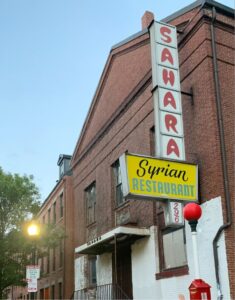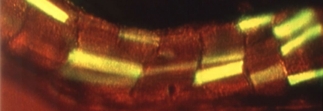
Sahara Syrian Restaurant building, Shawmut Avenue, Boston. Photo: Chloe Bordewich, Boston Little Syria Project
In honor of National Arab American Heritage Month, MIT Libraries encourages you to dig into some local resources that shed light on the history of Arab Americans.
“Arab Americans” refers to people who have immigrated to the United States from the Arab world and their descendants. The Arab world, stretching from Morocco in the west, to Iraq in the east, and to Yemen and Sudan in the south, varies substantially in its geography and culture, but is linked through the use of the Arabic language. Immigration from this vast region to the US dates back at least to the middle of the 19th century. The first waves of immigrants were predominantly Christians from the Arabic-speaking provinces of the Ottoman Empire (specifically from today’s Syria, Lebanon, Palestine, Israel, and Iraq). By the second half of the 2oth century, Muslims from across the Arab world accounted for the majority of immigration from the region. Thus, today’s Arab American community is religiously diverse.
Boston was an early hub for Arab Americans, boasting one of the largest communities in the country. It was here that Kahlil Gibran, the celebrated poet and author, immigrated with his mother and siblings in the 1880s. There were also significant communities across New England, in Worcester, Mass.; Lawrence, Mass.; Fall River, Mass.; Waterville, Maine; the Merrimack Valley; and northern Rhode Island. The history of Boston’s early Arab American community is the subject of the Boston Little Syria Project, which gives guided tours of the neighborhood once called “Little Syria” (between Chinatown and South End). The Little Syria Project mounted an exhibition in Rotch Library, which was also on display at the Massachusetts Historical Society.
Archnet, a digital library curated by MIT and the Aga Khan Trust for Culture focusing on the built environment of Muslim societies, features several resources related to the Arab American community and its impact on architectural history. The online collection Arab and Muslim Communities of Worcester, Mass. documents the influence of these communities on the built environment of the city of Worcester, specifically, which has been home to Arab immigrants since the middle of the 19th century. The collection springs from Arab-American Faces and Voices: The Origins of an Immigrant Community (University of Texas Press, 2003) by Elizabeth Boosahda (1926- October 24, 2017) and includes video of an interview with the author, as well as information about the religious and cultural institutions that the community established throughout the city, such as the El Morocco, a night club played by Frank Sinatra and other musical stars of the time.
